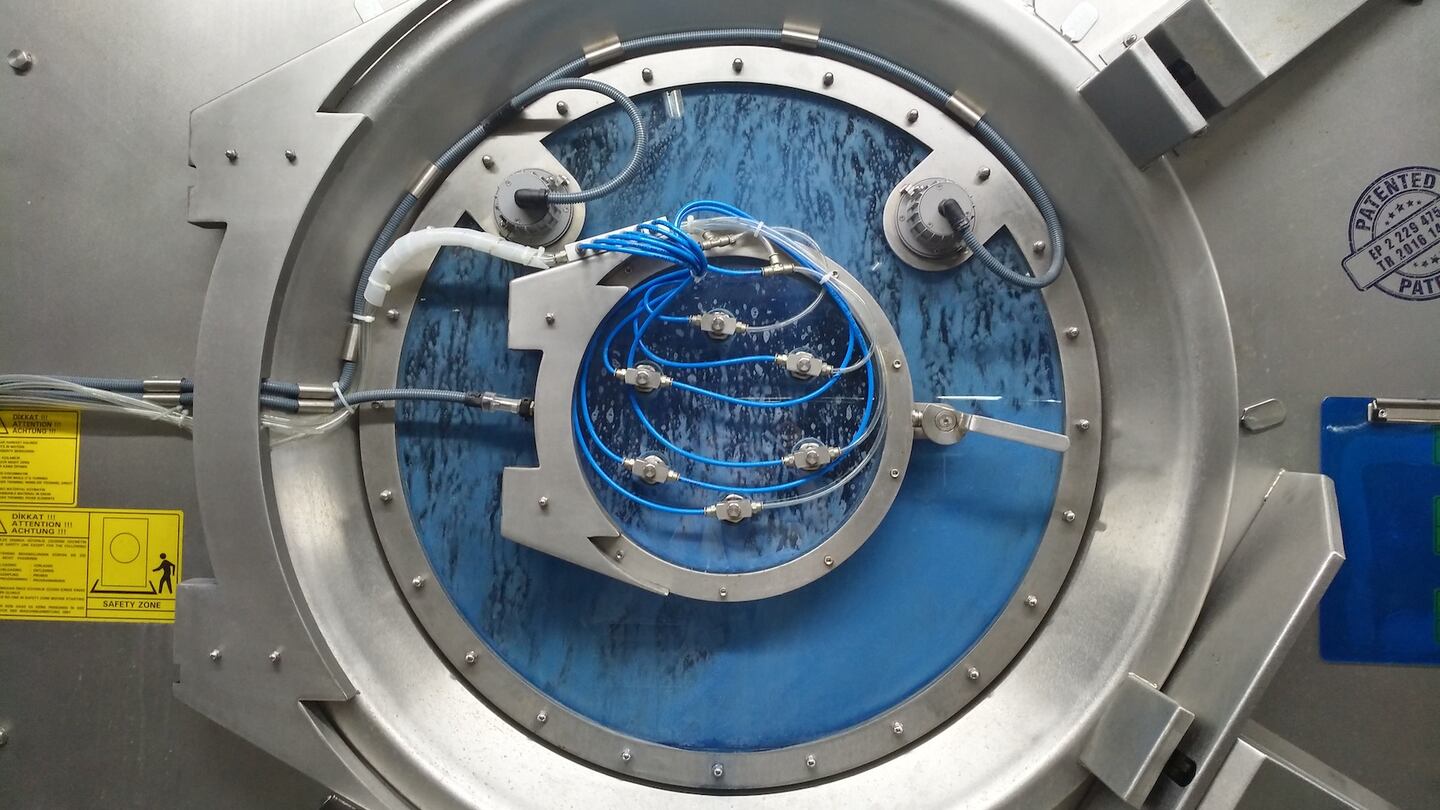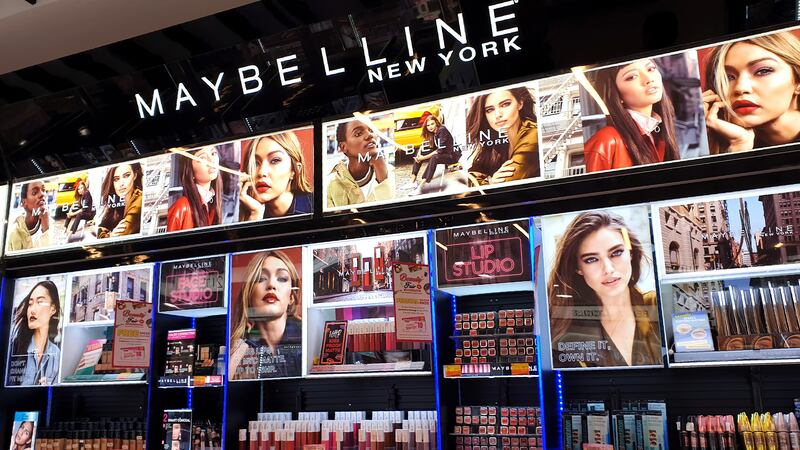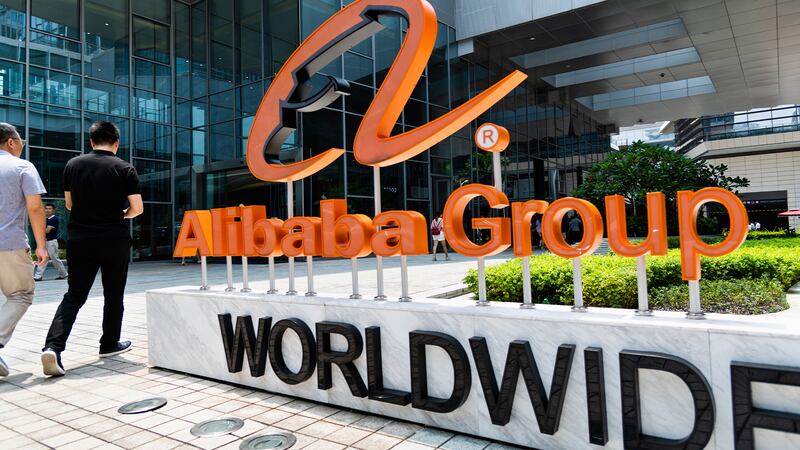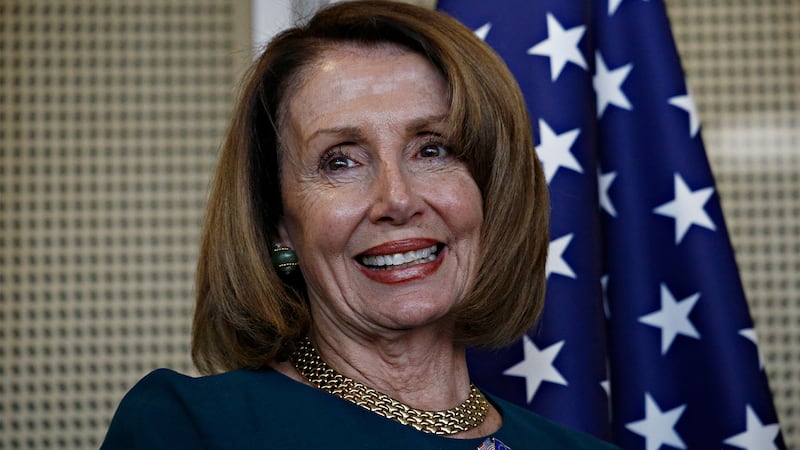
The Business of Fashion
Agenda-setting intelligence, analysis and advice for the global fashion community.

Agenda-setting intelligence, analysis and advice for the global fashion community.

China isn’t necessarily the first country that comes to mind when fashion industry leaders debate where the next big sustainable innovation will come from, but it is where several companies currently having a ‘green moment’ call home — and their common origin is by no means a coincidence.
Last month, Guangzhou-based Veshin Factory, which specialises in making handbags and accessories from leather alternatives, partnered with Ralph Lauren-backed material science company Natural Fiber Welding to use its plastic-free leather-like textile Mirum. Chemical recycling start-up Qingdao Amino Material Technology recently became the first Chinese winner of H&M Foundation’s Global Change Awards. Meanwhile, small-batch, made-to-order textile supplier Recyctex, based in Jiaxing, has become a mainstay in global trade shows and sustainable fashion summits thanks to its synthetic fibres made from traceable plastic waste and ventures into bio-based leather alternatives.
“China has the potential to become number one [in certain areas of sustainable innovation], but so far it still lags behind [leading hubs like Scandinavia], Germany, Switzerland and Japan,” said Shaway Yeh, founder of Shanghai-based sustainable fashion consultancy Yehyehyeh. “But now we’re at an [inflection point] because, there’s demand from Chinese consumers [and most importantly] from the Chinese government.”
Several prominent players in Chinese manufacturing have also become pioneers in the field — often quietly or gradually — in recent years. Hong Kong-listed Crystal International Group, which has a sizeable manufacturing footprint on the mainland supplying for brands including Levi’s, is now a standout for sustainability experts and advocates on account of climate goals that are ambitious relative to its peers. So far, it has reduced the carbon footprint of its products by 40 percent since 2007, when it first began its sustainability strategy, and reduced freshwater consumption per garment by 52 percent compared to 2017 levels.
ADVERTISEMENT
Other Chinese firms such as Chenfeng, Erdos, Esquel and High Fashion Group have grown from specialising in one product (such as yarns) to become vertically integrated operations, a transition that has been characterised as a move for stronger traceability and accountability across the value chain. It should be noted, however, that a subsidiary of the Esquel Group is currently facing criticism from workers’ rights advocates, a reflection of the complexities and contradictions that are sometimes inherent in the search for suppliers with both environmentally and socially responsible credentials.
Esquel Group has been heralded for its recently constructed green manufacturing park in Guilin, China, described by sustainable innovation heavyweight Edwin Keh as “state of the art sustainable” in an emailed exchange with BoF. But the manufacturing group’s Xinjiang-based subsidiary spinning mill, Changji Esquel Textile Co. Ltd., has been embroiled in forced labour allegations since 2020. More recently, it was among the more than 30 entities blacklisted under the US Government’s Uyghur Forced Labor Prevention Act, effectively banning imports that can be traced back to the Chinese province.
Esquel, which employs some 1,300 people in Xinjiang, is currently in litigation to challenge the move and has redoubled its “commitment” to operating there, despite concerns from its Western brand partners.
The current climate presents a thorny issue for manufacturers looking to push their sustainability credentials while toeing the line on domestic politics. “[T]he reality for companies operating in China is that they will face an increasingly hostile political environment should they be seen by Beijing as divesting from Xinjiang,” wrote Sofia Nazalya, a human rights analyst at risk consultancy Verisk Maplecroft, in a 2021 report.
Meanwhile, China has also been in the spotlight for its broader environmental record and commitments. It is by far the biggest global emitter of greenhouse gases (though not per capita) and its bold commitment to be carbon neutral by 2060, reaching peak emissions by 2030, surprised the global community — though experts warn it still falls short of necessary efforts to stave off the worst effects of global warming.
This has nevertheless increased awareness around sustainability issues in the country — and created a sense of purpose among the manufacturing sector at large. “In China, it’s very top-down,” said Yeh, referring to the influence of public policy and regulation on private-sector agendas.
In recent years, Chinese manufacturing has taken some significant hits. The Chinese government’s zero-Covid policy, as well as supply chain disruptions exacerbated by the war in Ukraine, have added to longer-term trends of fashion companies looking to diversify and near-shore their manufacturing bases amid rising geopolitical tensions between China and the West.
As labour and operating costs increased in China, fashion exporters from sourcing hubs like Bangladesh, Vietnam and Sri Lanka have been able to undercut their Chinese counterparts on price for ready-made garments. But beyond the final tier of apparel supply chains (where garments are assembled ready to be shipped to retailers), China’s vast infrastructure of raw material and textile production, which requires more sophisticated and expensive equipment, is hard to replicate elsewhere.
ADVERTISEMENT
Despite the many well-documented challenges facing the local manufacturing sector, China is still the world’s largest exporter of apparel, according to World Trade Organisation data. And since the ripple effect of Chinese supply chain shifts can be felt around the world, the country plays a critical role if the global fashion industry is to clean up its act in environmental terms.
To that end, the government has established aims to recycle 25 percent of the country’s textile waste by 2025, which would result in the production of 2 million tonnes of recycled fibre. Looming regulation of fashion’s circularity and traceability requirements in the European Union, a major importer of Chinese textiles and clothing, has further pushed it up the agenda for manufacturing executives.
Bolstered by its joining the World Trade Organisation in 2001, China rose to prominence as “the world’s factory” in recent decades, thanks to its competitive offering on price, speed and efficiency in its manufacturing sectors — often at the cost of operating in an environmentally and socially responsible way. But speak to any Chinese manufacturing executive with a robust present-day sustainability plan and they will likely reveal that it has been an area of focus for 15 to 20 years, albeit mostly behind closed doors.
At the beginning, we had to get management buy-in — that was very, very difficult.
This was typically brought about by a new, more progressive generation of management in family businesses, says Christina Dean, founder of Hong Kong-based sustainable fashion NGO Redress. “They’re third generation, they’re Ivy-League educated, they’re coming back [to China] at the top of their game… Looking back, some businesses were way ahead of [their time].”
The experience of Catherine Chiu, general manager of corporate quality and sustainability at Crystal International, similarly recalls the denim maker’s engagement with sustainability, which dates back nearly two decades. Building the capacity for necessary auditing and reporting was an uphill battle internally — even with the support of company chairman Kenneth Lo. “At the beginning, we had to get management buy-in — that was very, very difficult,” she told BoF. “Because we are garment manufacturers, our margins are very low.”
This kind of generational clash took more extreme tolls on less successful manufacturers due to “older generations not really understanding why the new upstart young leaders of these businesses, their children, wanted to rattle things up,” said Dean. In some cases, it resulted in businesses folding. “The sadness of that is that, had those companies been doing [the same innovations] now, possibly it would have been different.”
A long-standing challenge of implementing sustainable practices in any part of the fashion industry is that it costs money — an issue made all the more salient by the demands fashion brands put on their manufacturers to deliver cost-competitive products. Yuen estimates that the capex required to build Esquel’s new campus in Guilin was about two to three times that of a conventional factory with the same production capacity.
“There’s a real palpable frustration amongst many suppliers, I would say, for the fact that they’ve got many of the answers, but they’re not being paid to put the answers into practice,” said Dean of Redress.
ADVERTISEMENT
However, some suppliers are beginning to reap the benefits as brands, especially from Western markets, set their own sustainability commitments, such as increasing the proportion of products with lower-impact materials. Manufacturers like Hong Kong-listed High Fashion Group, which has been doing work on natural, biodegradable and recycled material production for years and built an impressive roster of certifications, stands poised to benefit from this shift.
There’s a real palpable frustration amongst many suppliers... for the fact that they’ve got many of the answers, but they’re not being paid to put the answers into practice.
“Because [brands] have a certain percentage of sustainable [products] to achieve as a minimum… they have a minimum allocation for us,” said Will Lam, High Fashion Group’s managing director. As a result, he added, “we have a more stable business, and we can see growth because they need to invest more and more in these resources.”
Shifts to energy-efficient operations and squeezing productivity out of energy units have obvious intrinsic benefits for manufacturers’ balance sheets. The improved sophistication — and lower costs of implementation — of key technologies like solar panels over the years has also made renewables a more attractive area of investment.

“We use the return on investment concept for sustainability,” said Chiu. For Crystal International, that means incrementally bringing in better technology and equipment and rolling them out more aggressively as their benefits become evident. “For all our sustainability initiatives, if the return on investment is five years, we are happy to invest.”
The proliferation of start-ups in recent years has created a culture of entrepreneurship and innovation in the Chinese market. “I [now] see a lot of very good environments for entrepreneurs to make their own business in China,” said Wenjian Hu, a member of the six-person team behind Qingdao Amino Material Technology founded in 2020.
Earlier this year, the start-up became the first mainland Chinese winner of H&M Foundation’s Global Change Award for its chemical recycling technology that successfully breaks down polyester-elastane blends commonly found in activewear. Its recycled elastane has a 70 percent lower carbon footprint than virgin counterparts, Hu claims, and after proving the technology in the lab, the company has its sights set on securing funds to accelerate production capacity for factory scale.
Larger businesses are also looking to boost their efforts in sustainable innovation, as executives look to reduce exposure to risk by diversifying their revenue streams. Within the coming decade, Esquel aims to make sustainability-focused research and development a third of its business (alongside its traditional manufacturing arm and burgeoning direct-to-consumer business), while Crystal International has sought out start-ups to collaborate with, with a view to implementing their green technology in wider operations.
Chinese manufacturing’s sustainability push, no matter how ambitious or progressive, is still fraught with labour rights concerns. Allegations of widespread forced labour and internment of Uyghurs and other minority groups in China’s Xinjiang region have put the country’s labour practices under the microscope and cast a pall over its global standing on the issue; China is one of just six G20 countries with “no guarantee of rights” for workers, according to ratings by the International Trade Union Confederation released in June.
Xinjiang aside, other Chinese provinces also carry a high risk of modern slavery, as well as other labour abuses relating to wages, working time and freedom of association, according to Verisk Maplecroft. While not as extreme as fellow textile and garment exporters Bangladesh and India, the risk of finding modern slavery in Chinese supply chains remains high, the firm found in its 2021 annual report.
To be sure, forward-thinking manufacturers will seek out their own social responsibility policies that place them as frontrunners compared to less-than-desirable industry averages. Crystal International, for example, became the first global manufacturer to partner with Better Work, a labour standards initiative spearheaded by the International Labour Organisation (ILO) and International Finance Corporation, in December 2019. It has also put nearly 50,000 of its female employees through empowerment programmes.
But the current state of play in China’s labour market is also shifting manufacturers’ approach to sustainability in more lateral ways. Rising labour costs and the current labour shortage have pushed executives to seriously look at implementing automation and drive efficiencies across the board.
In order to retain talent, we need to redefine jobs.
“People are still looking for more solutions; how to [operate sustainably] with less people,” said Lam of High Fashion Group.
Manufacturers are also putting stock into creating a talent pool of highly skilled professionals with sustainability training. High Fashion Group’s Womenswear Institute in Hong Kong, for example, has introduced more classes focused on equipping students with a technical knowledge of environmental sustainability.
“In order to retain talent, we need to redefine jobs,” said Yuen of Esquel.
Major sustainability transitions, especially in carbon emissions, often require public-private partnerships and a strong supporting infrastructure at the municipal or national level.
Increasingly, that is an area where China has the upper hand compared to other Asian nations. The country’s net-zero carbon emission commitments and textile waste recycling goals have helped establish a sense of direction and impetus for the manufacturing sector to align with.
That has been further bolstered by the recent introduction of subsidies and tax incentives, executives say. “This year, and last year, there are more and more incentives,” said Lam of High Fashion Group. “At the time when we started [working on sustainability initiatives] ... The government supported us by giving us awards, but not a lot of obvious incentives.”
Where on-site renewable energy sources like solar power are not feasible for a manufacturer, financing mechanisms like Power Purchase Agreements (PPAs) and Energy Attribute Certificates (EACs) allow businesses to sign long-term contracts to buy renewable energy in China. This is not always the case in other sourcing markets.
For its Vietnam-based operations, Crystal International was on the verge of signing a PPA contract in the Southeast Asian nation but hopes of this were dashed by last-minute policy changes by the Vietnamese government. Cambodia and Bangladesh similarly have limited supporting policies for successful renewable energy transitions, Chiu added.
Back in China, if Crystal International’s denim factory in Zhongshan, Guangdong, successfully reduces its wastewater output, it will receive government sponsorship and be encouraged to increase production capacity. And with the costs of labour and other overheads in China’s first-tier cities rising, municipalities in lower-tier cities are enticing manufacturers to set up shop for new state-of-the art factories with low or no rent and renewable energy sources.
But with or without regulatory incentives, a growing number of Chinese manufacturers see sustainability as a necessary future-proofing exercise.
“If we are not able to invest in this kind of technology, we are not able to survive,” said Chiu.
THE LATEST NEWS FROM CHINA
by Zoe Suen
时尚与美容
FASHION & BEAUTY

Maybelline Changes Gears in China as L’Oréal Sales Defy Lockdowns
After media outlets reported that the American make-up brand was planning on closing all physical stores in the mainland market while maintaining its online presence, Maybelline clarified that shutdowns are only affecting underperforming storefronts and leases nearing their end. The move, its New York team says, is part of a “strategic transformation” of its offline channels to integrate them with digital commerce. The brand still operates approximately 10,000 storefronts in China, including drugstore concessions, and its online channels, but has in recent years lost market share to buzzy upstarts, including homegrown C-Beauty competitors. The news came as owner L’Oréal reported global sales of €9.31 billion ($9.46 billion) for the three months to June and in China, revenue growth of 13 percent over the quarter — defying the approximate 6 percent drop in the overall market due to Covid-Zero policies and poor consumer sentiment. CEO Nicolas Hieronimus attributed the group’s performance to strong e-commerce sales. (WWD, Reuters)
LVMH, Richemont, Burberry Present at Annual Hainan Expo
Luxury’s biggest names pulled out all the stops at the second China International Consumer Expo, which opened in Haikou, the capital of Hainan province, last week. Richemont, Dolce & Gabbana, Burberry, L’Oréal, Estée Lauder and Coty, were among the 1,322 exhibitors to show support for the mainland’s duty-free market and its focal point Hainan. Over the course of the five-day event, the local government handed out coupons worth $14.8 million to stimulate consumption, adding to the number of favourable policies that have helped the island become China’s travel retail hub, and will see it draw more visitors as domestic travel restrictions loosen. Meanwhile, Andrew Wu, LVMH’s group president for Greater China, inked a partnership with Haikou’s Integrated Free Trade Zone, which will see the luxury giant launch a warehouse in the zone for its beauty travel retail operations. (Jing Daily)
Esprit Plots Global Comeback Despite Macroeconomic Headwinds
Even as inflation soars and supply chains remain log-jammed, William Pak, CEO of Hong Kong-based Esprit Holdings, thinks fashion could soon be out of the woods. Esprit exited North America, Australia and Asian markets in the last decade and shuttered hundreds of stores. Now, it’s putting in motion a comeback in markets like China and is counting on a rebound while distancing itself from fast fashion players, many of which have exited the mainland market in recent months. Though it has no “specific target” for revenue distribution across Asia, Esprit plans on appealing to Chinese youths by releasing products with a guochao (national pride) bent and increasing apparel quality as it reduces the number of collections released per year. (The Financial Times)
科技与供应链
TECH & SUPPLY CHAIN

Weibo, Douyin Begin Displaying KOLs’ Multi-Channel Networks
In mid-July, Chinese social media platforms like Weibo and TikTok sister app Douyin began testing a new addition to their interfaces: displaying the names of commercial agencies on KOLs’ (key opinion leaders’) profiles. The backbone of China’s influencer economy, these agencies, known as MCNs or multi-channel networks, manage KOL projects and contracts across channels from social media and e-commerce. According to iiMediaResearch, there were over 30,000 MCNs in China as of 2021 and the MCN market recorded 33.5 billion yuan ($4.96 billion) in revenues the same year. Revealing the MCNs behind KOL accounts — like platforms’ recent moves to unveil where users were posting from — is part of a Beijing-backed move for online transparency. (Technode)
Baidu Bets on Virtual Livestream Hosts, Avatars
On July 21, the firm behind China’s biggest search engine hosted its annual Baidu World Conference and launched a livestream platform housing virtual broadcasters – digital avatars who will man round-the-clock, AI-backed streams — and a virtual avatar system that will allow every Baidu user to build their own virtual counterpart. Considering recent incidents with top livestream stars like Austin Li Jiaqi and Viya, who were suspended for showing politically sensitive content and tax evasion respectively, betting on virtual hosts seems to make sense, and the move is also expected to reduce production costs. How popular or influential virtual KOLs of the future might be compared to their real-world counterparts remains unclear. Focusing on virtual avatars might give Baidu an edge, but competition among platforms is fierce despite uncertainty around Web3′s regulatory future, with the likes of Alibaba and Tencent pouring money into metaverse initiatives like digital collectables and VR. (Jing Daily)
China’s Factory Activity Contracts Sharply in July Despite Signs of Recovery
Last month, China’s official manufacturing purchasing managers’ index (PMI) unexpectedly shrank to 49, down from 50.2 in June, data from the National Bureau of Statistics reveals. The PMI’s 50-point mark distinguishes growth from contraction by the month, and the news comes despite some signs of economic recovery, leading analysts to forecast that the reading would stay level with June’s figure. Earlier this month, official data highlighted improvements in retail sales performance and industrial production, which rose by 3.1 percent year-on-year and 3.8 percent year-on-year, respectively. On Sunday, state-owned outlet Xinhua News warned that “the foundation of China’s economic recovery is still not sound, and it will take painstaking efforts to consolidate the momentum of improvement,” citing factors like a “severe international environment” and the pandemic. (South China Morning Post)
China’s Digital Yuan Has Yet to Take Off Eight Years Later
It’s been eight years since China first kickstarted plans for its own digital currency, and the central bank’s programme for it has since extended into 23 cities housing almost a fifth of the country’s people, around the same number that has created a digital wallet on the bank’s app. But why has a full launch stalled? For starters, the convenience of mobile payments apps like Alipay and WeChat Pay don’t give shoppers much of an incentive to switch, and there have also been lags in processing payment information. For retailers, the digital yuan could be a boon, allowing them to process payments without paying fees or internet connections. Convincing the public to adopt the digital yuan is the government taskforce’s main mission, but ahead of this fall’s Communist Party Congress, President Xi Jinping is unlikely to rock the boat. (KrAsia)
消费与零售
CONSUMER & RETAIL

Alibaba to Seek Hong Kong Listing
The retail giant, which debuted in New York in 2014, will pursue a primary listing in the Asian financial hub, a move expected by the year’s end which could pave the way for around 200 US-traded mainland firms like rival JD.com and Baidu that could get delisted from US stock markets depending on geopolitical tensions between Washington and Beijing. Amid expectations that Beijing’s years-long crackdown on tech is waning, the listing could activate Hong Kong’s Stock Connect link with exchanges in Shanghai and Shenzhen, allowing investors in China to directly buy Alibaba shares for the first time, and expanding the group’s investor base. The listing could also help make Hong Kong a popular alternative venue for Chinese companies looking to list, cementing the financial hub’s status after years of political and Covid-19 related economic woes. (Bloomberg)
Report: Chinese On-Demand Retail Market to Exceed $148 Billion by 2025
Q-commerce is expected to become even bigger business in China. According to a new white paper published by JD.com’s on-demand platform Dada Group and the China Chain Store and Franchise Association, China’s market for on-demand retail — defined in it as transactions where shoppers’ online orders are fulfilled within an hour, by brick-and-mortar retailers located within a 3 to 5 kilometre radius — is forecast to beat the trillion yuan mark (about $148 billion). The report highlights on-demand retail’s role as a growth driver for the wider online-to-offline retail industry, a role that became crucial for retailers during the pandemic when shuttered offline stores served as full-time as fulfilment hubs. (Technode)
Asia’s First Professional Cargo Airport Unveiled in Hubei
As the popularity of air cargo accelerated during the pandemic and the sector is forecast to keep growing in the years ahead, Hubei appears to be in pole position to take advantage of the logistics solution needed for fast fulfilment between trade partners in Asia and western countries. On July 17, a Boeing 767-300 cargo plane took off from Ezhou Huahu Airport in China’s Hubei province, marking the official launch of the mainland’s first professional cargo hub airport, which also offers passenger flights for the region. The site features a terminal of 23,000 square metres, a freight transit centre spanning almost 700,000 square metres and two runways. The airport has already opened two routes to Shenzhen and Shanghai, and is planning global routes to Osaka and Frankfurt this year, followed by 10 international routes and 50 domestic routes by 2025, by which time its cargo and mail throughput is expected to reach 2.45 million tonnes. SF Express, China’s top logistics service provider, holds a 46 percent stake in the airport operator, and plans on processing most of its packages through the site in the future. (Fibre2Fashion)
政治,经济与社会
POLITICS, ECONOMY, SOCIETY

Nancy Pelosi Embarks on Asia Tour as Sino-US Tensions Flare Up
US House of Representatives Speaker Nancy Pelosi kicked off her highly anticipated Asia trip on August 1. After landing in Singapore, she us expected to visit Malaysia, South Korea and Japan. Though many have speculated that a Taiwan visit is on the cards, her office has yet to make a mention of a stopover there. The news follows several heated warnings from Beijing over a potential official US exchange with the self-ruled island, which the Chinese government regards as a breakaway province, making a visit, in its eyes, a demonstration of support by the US for “Taiwan independence.” A statement from the Chinese Defense Ministry implied that the government would pursue military force if Pelosi did indeed visit, and the mainland held live-fire drills off the coast of Fujian, across the strait from Taiwan over the weekend. (South China Morning Post)
UK Firms Cutting Ties with China Amid Political Tensions, Says CBI Chief
Thousands of British firms are rethinking supply chains as UK tensions with China worsen, Tony Danker, the director general of The Confederation of British Industry (CBI) said. Danker warned that as the UK works to rejig its trade partnerships, a sudden shift in supply chain restructuring will likely worsen the cost of living crisis. But doing so is necessary, he adds, as failing to adapt amid an accelerated wider decoupling by Western firms from China would inflate costs for those still dealing with mainland partners. “It doesn’t take a genius to think cheap goods and cheaper goods may be a thing of the past,” said Danker. Last week, contenders to become the UK’s new prime minister Liz Truss and Rishi Sunak both pledged to stand up to China, which they view as a threat to Britain’s national and economic security. (The Guardian)
China and EU Pledge ‘United Front’ on Economic Headwinds, Supply Chain Disruptions
The ninth China-EU High-Level Economic and Trade Dialogue (HED) was held on July 19, co-chaired by Chinese vice premier Liu He and Valdis Dombrovskis, executive vice president of the European Commission. The two sides managed to land on a number of deliverables that will define their cooperation on issues like macro-economic policies, WTO reform, market opening-up and supply chains. On the last point, the two agreed to ramp up collaboration to tackle supply chain disruptions alongside bilateral trade and investment, with deliverables including exchanging information on the supply of critical raw materials. To cultivate a more inviting business environment, China and the EU agreed to actively promote trade, fair competition and protect intellectual property rights. (EU Observer)
China Decoded wants to hear from you. Send tips, suggestions, complaints and compliments to robb.young@businessoffashion.com.
With consumers tightening their belts in China, the battle between global fast fashion brands and local high street giants has intensified.
Investors are bracing for a steep slowdown in luxury sales when luxury companies report their first quarter results, reflecting lacklustre Chinese demand.
The French beauty giant’s two latest deals are part of a wider M&A push by global players to capture a larger slice of the China market, targeting buzzy high-end brands that offer products with distinctive Chinese elements.
Post-Covid spend by US tourists in Europe has surged past 2019 levels. Chinese travellers, by contrast, have largely favoured domestic and regional destinations like Hong Kong, Singapore and Japan.